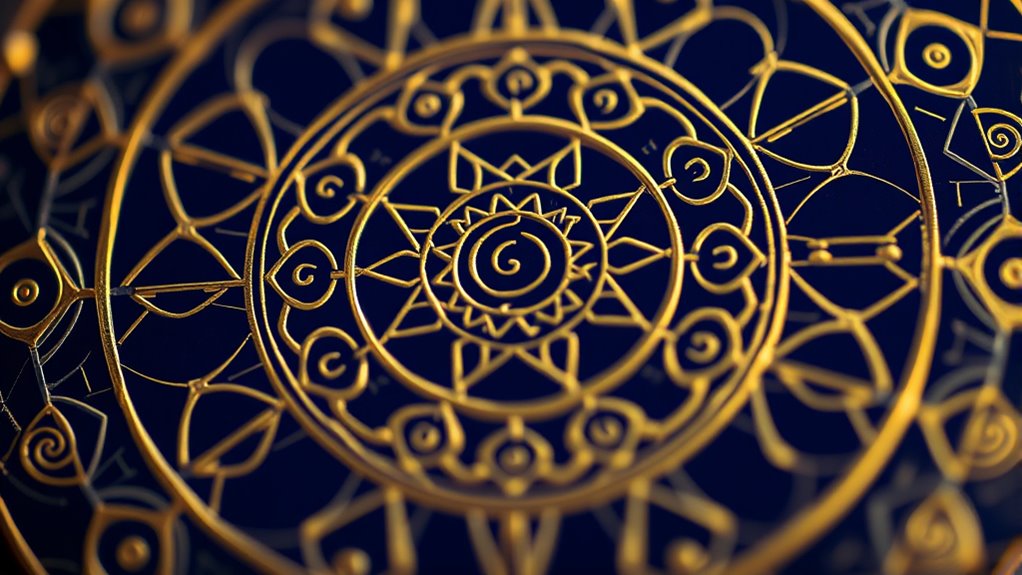Sacred geometry blends precise mathematical ratios like the golden mean with rich spiritual symbolism, offering both scientific insight and metaphysical meaning. It acts as a universal language that highlights the underlying order and harmony of the universe. You’ll discover that these shapes and patterns serve not just as mathematical constructs but as symbols for higher consciousness and divine truths. Exploring this connection can reveal how science and spirituality intertwine, and there’s more to uncover if you continue exploring.
Key Takeaways
- Sacred geometry combines precise mathematical ratios with spiritual symbolism, serving as both a universal blueprint and metaphor.
- The mathematical patterns, like the golden mean, reveal underlying structures, while their symbolic meanings inspire spiritual insight.
- It is viewed as a fusion of scientific precision and metaphoric language for understanding higher truths.
- Geometric forms embody harmony and order, bridging physical proportions and metaphysical concepts.
- Its dual nature enhances both analytical appreciation and spiritual reflection, illustrating its role as mathematics and metaphor.

Sacred geometry is the study of symbolic shapes and patterns that recur across different cultures and spiritual traditions. When you explore these geometric forms, you’ll notice they often embody a sense of harmony and order that seems to transcend individual belief systems. Many believe that these shapes are rooted in mathematical precision, revealing an underlying structure to the universe itself. This connection is sometimes explored through specific ratios like the golden mean, which appears in various natural and architectural forms. This isn’t just about abstract math; it’s about the way these precise patterns hold spiritual symbolism, acting as bridges between the physical and metaphysical spheres. You might find yourself drawn to symbols like the Flower of Life or the Fibonacci spiral, which appear in everything from ancient temples to modern art. Their mathematical consistency suggests a universal blueprint, hinting that the cosmos follows a set of precise, rule-based principles.
Yet, whether sacred geometry is primarily about mathematical precision or spiritual symbolism depends on how you interpret it. For some, these shapes are literal representations of the universe’s fundamental code, revealing a hidden order that can be decoded through numbers and ratios. They see the proportions and ratios—like the golden mean—as evidence of a divine blueprint woven into the fabric of reality. Others view these patterns as symbolic tools, serving as metaphors for spiritual truths. They believe that the shapes inspire inner reflection and spiritual awakening, acting as visual language for complex divine concepts. From this vantage point, sacred geometry isn’t about exact calculations but about the way these forms evoke a sense of connection, unity, and higher consciousness.
You might also consider that sacred geometry serves both purposes simultaneously. Its mathematical precision lends credibility to its universality, suggesting that these patterns aren’t random but part of a grand design. Understanding mathematical ratios is fundamental to grasping its significance, as these ratios underpin the structure of many sacred forms. Exploring the geometric proportions involved can deepen your appreciation of their harmony and significance. At the same time, its rich spiritual symbolism invites you to see these shapes as more than mere numbers—they’re windows into deeper truths about existence and consciousness. When you meditate on these forms, you could find that their precision calms your mind, while their symbolism deepens your spiritual understanding. Ultimately, sacred geometry weaves together the tangible and intangible, inviting you to explore the relationship between the measurable universe and the profound mysteries it holds. The study of these shapes often involves understanding mathematical ratios, which are fundamental to their structure and significance. Whether viewed through a scientific or spiritual lens, the recurring patterns remind you that both worlds are interconnected in a delicate, beautiful harmony.
Frequently Asked Questions
How Does Sacred Geometry Relate to Modern Scientific Theories?
You might wonder how sacred geometry connects to modern science. It relates through concepts like quantum physics, where patterns and structures mirror geometric forms, and mathematical symbolism, which helps explain complex phenomena. Sacred geometry offers a visual language that echoes scientific theories, suggesting a universal order. By exploring these connections, you see how ancient shapes can symbolize the fundamental principles underlying nature and the universe’s intricate design.
Can Sacred Geometry Be Used in Contemporary Architectural Design?
You can definitely use sacred geometry in contemporary architectural design. It incorporates symbolic proportions and aesthetic principles that create harmony and balance in structures. By applying geometric patterns like the golden ratio, you enhance visual appeal and evoke spiritual or cultural significance. Modern architects often use these timeless concepts to craft innovative, meaningful spaces that resonate on both an aesthetic and symbolic level, blending tradition with contemporary design.
Are There Cultural Differences in Sacred Geometry Interpretations?
Imagine sacred geometry as a global tapestry, each culture weaving its own patterns with unique threads. You’ll see cultural symbolism shaping interpretative variations, revealing how different societies perceive divine harmony. These differences reflect rich traditions and beliefs, making sacred geometry a vibrant dialogue rather than a fixed blueprint. So, yes, cultural nuances influence how sacred shapes are understood, highlighting diverse spiritual expressions across civilizations.
What Historical Civilizations Utilized Sacred Geometry?
You see, many ancient civilizations, like the Egyptians, Greeks, and Indians, utilized sacred geometry in their architecture and art. They believed these geometric patterns held deep spiritual significance and represented universal harmony. By exploring their structures and symbols, you can uncover ancient symbolism that reveals their spiritual beliefs. These civilizations used sacred geometry not just as mathematics, but as a way to connect with higher spiritual truths and divine order.
Is Sacred Geometry Applicable in Digital or Virtual Environments?
You can apply sacred geometry in digital and virtual environments, enhancing digital aesthetics and deepening virtual symbolism. By integrating geometric patterns, you create visually compelling interfaces and immersive experiences that resonate on a symbolic level. This approach bridges ancient wisdom with modern technology, allowing you to evoke a sense of harmony, spirituality, and interconnectedness within digital spaces, making virtual interactions more meaningful and aesthetically pleasing.
Conclusion
You might think sacred geometry is just poetic symbolism, but it’s also a fascinating reflection of universal patterns you can see in nature and architecture. Don’t dismiss it as mere metaphor—these shapes reveal underlying mathematical truths that connect us all. Embracing both perspectives enriches your understanding, showing that sacred geometry isn’t just about spiritual symbolism but also a meaningful language of the cosmos. So, explore these patterns—they might just change how you see the world.










